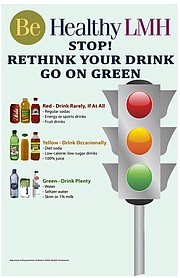Sugar, in the form of carbohydrates, stimulates the release of the “feel-good” hormone serotonin.
The taste of sugar releases endorphins that help calm and relax us, providing a kind of “high.”
By Aynsley Anderson, Lawrence Memorial Hospital
Tuesday, July 14, 2015
Why do so many of us like or even crave sweet drinks and treats? There may be a lot of reasons, including evidence that we are wired from early infancy onward to prefer the taste of sweet over other flavors.
Sugar, in the form of carbohydrates, stimulates the release of the “feel-good” hormone serotonin. The taste of sugar releases endorphins that help calm and relax us, providing a kind of “high.” There is some evidence that sugar may activate the same part of the brain that other addictive substances like cocaine and heroin do.

Aynsley Anderson, MA, RN LMH Community Education Coordinator.

Lawrence Memorial Hospital has launched a Healthier Living Initiative, and new signs use a stoplight classification system to remind employees which snacks offer the healthiest options.
Lastly, we often use sugar as a reward for a job well done, such as eating a healthy meal, exercising or completing a big project.
The United States Department of Agriculture notes that Americans’ average daily calorie intake has significantly increased in the past 50 years. This is mostly due to increased consumption of sugar-laden beverages like soft drinks, energy and sports drinks, and sweetened tea.
According to the Cleveland Clinic, the average adult consumes 152 pounds of added sugar each year or about 22 teaspoons a day. This amounts to an extra 350 calories a day and is well beyond the daily maximum amount recommended by the American Heart Association, which is less than 6 teaspoons a day (about 100 calories) for women and less than 9 teaspoons a day (about 150 calories) for men.
Consuming sugar from a soda, a chocolate bar or breakfast cereal increases insulin production as the body tries to bring blood glucose levels back to normal. What can happen next then is a “sugar crash,” which can lead to craving for more sugar. This may start a blood sugar roller-coaster ride throughout the day.
Here are nine tips from the American Academy of Dietetics to help beat a sugar habit:
- Drink plenty of calorie-free water.
- If tolerated, include low-fat milk in your daily beverage intake.
- Keep juice intake to a maximum of 4-6 ounces a day. If you drink juice, choose 100 percent fruit juice. Even better is to opt for fresh fruit and vegetables, which provide fiber and phytonutrients.
- If consuming sweetened beverages, opt for the smallest serving size.
- Be a sugar sleuth: Learn to read labels and to identify “code” words that indicate sugar or another sweetener is contained within the product. For more about artificial sweeteners, visit the website hsph.harvard.edu.
- Know the acceptable daily intake (ADI) for artificial sweeteners such as saccharin or aspartame. With these, you can also have too much of a good thing. For more about this topic, go to nlm.nih.gov or fda.gov.
- Make sure to eat regular meals containing protein (preferably a lean source), which helps to keep you full.
- If hungry between meals, reach for healthy snacks like nuts or yogurt with fresh fruit.
- If you feel a sugar craving coming on, go for a walk or reach for a piece of fresh fruit instead. If the sugar craving is so intense you can’t ignore it, have a small piece of dark chocolate or another small taste of a desired treat. But avoid doing this several times a day.
Aynsley Anderson, MA, RN, is Community Education Coordinator at Lawrence Memorial Hospital, which is a major sponsor of WellCommons. She can be reached at aynsley.anderson@lmh.org.
Healthier Living Initiative
Lawrence Memorial Hospital has launched a Healthier Living Initiative. The plan addresses four areas beginning with removing sugared drink options from the fountain dispensers in the LMH cafeteria.
This initiative will phase in healthier beverage offerings, provide an “At-A-Glance” classification system to make those choices more easily identifiable, and incorporate healthier snack options for employees and visitors.
The other phases, which will roll out over the next year, include modifying drink options sold in cans and bottles in the cafeteria and vending machines; modifying juice drink options; and modifying food options available in the cafeteria and vending machines.
LMH has chosen to adopt a stoplight classification system with red, yellow and green labels, which signify:
- Red – Drink/eat rarely, if at all.
- Yellow – Drink/eat occasionally.
- Green – Drink/eat plenty!
In announcing the Healthier Living Initiative on July 1, LMH President and CEO Gene Meyer said, “At Lawrence Memorial Hospital, we have the opportunity to demonstrate the value of healthy living by our community leadership. One way we can do this is by providing healthier food and beverage choices for LMH associates and visitors.”